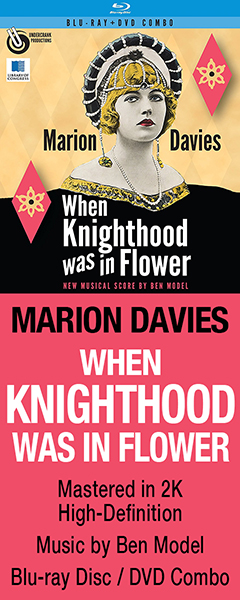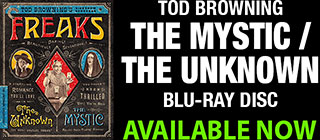Silent Era Home Page > Home Video > Diary of a Lost Girl

Reviews of silent film releases on home video.
Copyright © 1999-2024 by Carl Bennett
and the Silent Era Company.
All Rights Reserved. |
|
Diary of
a Lost Girl
(1929)
|
Thymian (Louise Brooks) is celebrating her confirmation. Yet, on the day of her celebration, Elizabeth the housekeeper leaves in shame. It is clear that Henning, Thymian’s father, has been dallying with her. Elizabeth commits suicide. Louise catches Meta, the new housekeeper, in the arms of her father. When Louise is overcome by the suicide and her discovery, Meinert (Fritz Rasp), the leering and lustful manager of Henning’s pharmacy, rapes her. Later, she bares his child but has refused to reveal the baby’s father to the family. Meta produces Thymian’s diary and Meinert is revealed. When confronted, Meinert refuses to marry Thymian, who doesn’t want anything to do with him either. The family decides for Thymian that the child is to be quietly placed in adoption. It is apparent that Meta is controlling the situation as Henning resignedly allows Thymian to be put into a rigidly-controlled workhouse for wayward girls.
In the reformatory, Thymian directs her appeals for help not to her father but to a friend of the family, the nephew of Count Osdorff. Meinert, still in the Henning pharmacy, is present when Henning marries Meta. Controlling Meta is happy to be presented with the keys to the Henning household. When Osdorff arrives to petition for Thymian, Meta quietly and firmly rebuffs him with sheepish Henning present. Later, with Meta pregnant with the child she has longed for, Meinert purchases the mortgages on Henning’s pharmacy. Meanwhile, Osdorff goes to the workhouse to speak with Thymian, bringing news of her father’s marriage to Meta. With no one left to turn to, Osdorff encourages Thymian to escape the reformatory that evening. The sadistic headmistress attempts to confiscate Thymian’s diary, is thwarted by the girls, and Thymian escapes with her friend, Erika.
Erika takes Osdorff to stay in a place she knows. Thymian returns to the midwife who accepted her child. The midwife claims that the child has died and was just taken away. Depressed, Thymian wanders the streets until she is taken away by a street vendor. Erika and Osdorff are housed happily in a brothel when Thymian arrives with the vendor. Thymian is dressed in a fashionable gown and instantly becomes the center of attention. Lured by alcohol and merry times the semi-conscious Thymian succombs to prostitution. Facing homelessness or prostitution, and now aware of the paltry economic status of the repudiated Osdorff, Thymian offers (as Louise Brooks herself would a few years later) to teach dance lessons. With the brothel madame’s slight alteration to the ad, men soon arrive expecting a dance lesson of the horizontal sort. Her first student soon has his assumptions straightened out by the brusque Dr. Vitalis. One evening, Thymian decides to raffle an evening of her dancing(?) services to raise money for the broke and drunken Vitalis. Escorted by the smarmy Meinert, Henning and Meta are somewhat chagrined to arrive for dinner in the nightclub/brothel, only to see Thymian on display. Across a crowded dance floor a grim father and daughter try to reunite, but Meta steps in to guide Henning away from the shame.
Three years later, still at the brothel, Thymian receives notice that her father has died. Thymian is to attend the reading of her father’s will. With the encouragement of her friends, Thymian begins to dream that she might be able to start her life over again with the inheritance of her father’s estate. It is suggested that she need a new identity and marry Osdorff to become a countess. On a handshake, they agree. At the reading of the will, Meinert exercises his control of the mortgages to seize the pharmacy and the house containing it, effectively putting Meta and her two children on the street. Thymian receives 45,000 marks from Meinert to obtain sole control of the business and property, which she selflessly gives to Meta and her children. A surprise ending awaits the audience and Thymian.
As with several of her films, Louise Brooks remains one of the best qualities of them although she was only an average actress (is this sacrilege?) who can occasionally be caught on camera receiving the direction of her performance.
From the first shot of Louise, she is beautiful in this film. Even later, with her famous hair bangs slicked back in a decidedly male fashion for reformatory life, Louise is stunning.
As in Pandora’s Box (1929), Fritz Rasp here plays a slimy character to audience-provoking perfection.
— Carl Bennett
|
 Kino Classics Kino Classics
2015 Blu-ray Disc edition
Diary of a Lost Girl (1929), black & white, 112 minutes, not rated,
with Windy Riley Goes Hollywood (1931), black & white, 18 minutes, not rated.
Kino Lorber, K1970, UPC 7-38329-19702-5.
One single-sided, dual-layered, Region A Blu-ray Disc, 1.33:1 aspect ratio image in pillarboxed 16:9 (1920 x 1080 pixels) progressive scan AVC (MPEG-4) format, SDR (standard dynamic range), ? Mbps average video bit rate, ? Mbps audio bit rate, LPCM 2.0 stereo sound, German language intertitles, optional English language subtitles; 10 chapter stops; standard BD keepcase; $29.95.
Release date: 20 October 2015.
Country of origin: USA
|

This Blu-ray Disc edition has been remastered for home video in a new 2K high-definition video transfer from archival 35mm elements controlled by the F.W. Murnau Stiftung. The results are often excellent, with increased image detail that surpasses our hopes for this edition. Detractors may note the pronounced film grain seen in some of the shots, and the emulsion and film base scratches seen in footage conflated from a worn 35mm print into the main 35mm source material. We don’t care since this is such an improvement on the aged 2001 Kino edition that is noted below.
The film is accompanied by a piano music score performed by Javier Perez de Azpeitia.
The supplementary material includes a new audio commentary by Thomas Gladysz, director of the Louise Brooks Society, Windy Riley Goes Hollywood (1931) presented in standard resolution, featuring a newly-repatriated (to Hollywood) Louise Brooks, and a promotional trailer for the BD edition (1 minute).
At a glance, we are quite impressed with the image quality of this new home video edition of Louise Brooks’ last great film and recommend it enthusiastically to Brooks fans and silent film collectors alike.
|
|
USA: Click the logomark to purchase this Region A Blu-ray Disc edition from Amazon.com. Your purchase supports Silent Era.
|

|
|
|
Canada: Click the logomark to purchase this Region A Blu-ray Disc edition from Amazon.ca. Your purchase supports Silent Era.
|

|
|
 Kino Classics Kino Classics
2015 DVD edition
Diary of a Lost Girl (1929), black & white, 112 minutes, not rated,
with Windy Riley Goes Hollywood (1931), black & white, 18 minutes, not rated.
Kino Lorber, K1969, UPC 7-38329-19692-9.
One single-sided, single-layered, Region 1 NTSC DVD disc, pillarboxed? 16:9? (720 x 480 pixels) progressive? scan MPEG-2 format, SDR (standard dynamic range), ? Mbps average video bit rate, ? Kbps audio bit rate, Dolby Digital 48 kHz 2.0 stereo sound, German language intertitles, optional English language subtitles, chapter stops; standard DVD keepcase; $24.95.
Release date: 20 October 2015.
Country of origin: USA
|
|
This remastered DVD edition has been transferred for home video from a new 2K high-definition video scan utilizing archival 35mm elements controlled by the F.W. Murnau Stiftung.
The film is accompanied by a piano music score performed by Javier Perez de Azpeitia.
The supplementary material includes a new audio commentary by Thomas Gladysz, director of the Louise Brooks Society, Windy Riley Goes Hollywood (1931) presented in standard resolution, featuring a newly-repatriated (to Hollywood) Louise Brooks, and a promotional trailer for the BD edition (1 minute).
|
|
USA: Click the logomark to purchase this Region 1 NTSC DVD edition from Amazon.com. Your purchase supports Silent Era.
|

|
|
|
Canada: Click the logomark to purchase this Region 1 NTSC DVD edition from Amazon.ca. Your purchase supports Silent Era.
|

|
|
 Kino on Video Kino on Video
2001 DVD edition
Diary of a Lost Girl (1929), black & white, 116 minutes, not rated,
with Windy Riley Goes Hollywood (1931), black & white, 18 minutes, not rated.
Kino International, K225DVD, UPC 7-38329-02252-5.
One single-sided, single-layered, Region 0 NTSC DVD disc, 1.33:1 aspect ratio image in full-frame 4:3 (720 x 480 pixels) interlaced scan MPEG-2 format, SDR (standard dynamic range), 6.5 Mbps average video bit rate, 192 Kbps audio bit rate, Dolby Digital 48 kHz 8-bit 2.0 stereo sound, English language intertitles, no foreign language subtitles, 16 chapter stops; standard DVD keepcase; $29.95.
Release date: 13 November 2001.
Country of origin: USA
Ratings (1-10): video: 8 / audio: 8 / additional content: 6 / overall: 8.
|

With Louise Brooks enshrined as an irrefutable icon of the silent era of films, any home video release of one of her films is news, especially when the film features her last great role and when the film is presented in a fine new edition such as the one at hand. The disc features approximately seven minutes of footage previously unavailable on home video.
This video transfer was prepared from a restoration print prepared by L’Immagine Ritrovata and distributed by Transit Films/Friedrich Wilhelm Murnau Stiftung, current controller of many of the German films from the late silent era. The print features a clarity of detail, with broad greyscale ranges featuring detailed highlights and open shadows, that hasn’t been seen before in America in post-release prints of this film. The restoration print still has the usual amount of persistent speckling, dust and moderate print damage in the form of scuffing, lengthy scratches, emulsion chipping and decomposition, splices, timing marks, and sprocket damage in the image area of some sections of the print. The video transfer itself departs from the example of other recent Kino releases in that the digital resolution of the transfer and video bit rate is high enough (with video compression low enough) to replicate the original print’s film grain but without introducing many perceptible digital artifacts. The video bit rate does not fall lower than 5 Mb per second and occasionally hovers up around 8 to 9 Mb per second, rendering a reasonably faithful video representation of the source print.
The musical accompaniment has been composed and performed by Joseph Turrin. The well-composed and pleasing music is a fine example of silent film accompaniment, but it has also been performed on a digital piano and synthesizers which leaves us wishing for true strings and woodwinds in this otherwise good recording.
Windy Riley Goes Hollywood (1931) has been included as the disc’s only supplemental material. This Mermaid Talking Comedy was originally distributed by Educational, a poverty-row studio who provided work to a number of silent era performers in the 1930s including Roscoe Arbuckle (the director of this film). In the film, Jack Shutta as Windy ‘Cannon Ball’ Riley is on a record-breaking nonstop automobile drive from New York to San Francisco, but circumstances land him in Hollywood, where he winds up working for a film studio as a publicity man. The film does offer a look at early sound film production (as presented for consumption by ’30s audiences) and a brief moment where Louise dances. Brooks turns in an uninspired performance and sometimes doesn’t speak loud enough to be picked up well by the primitive microphones of the time. It is no wonder that after this film (preceded by bit parts in two American sound features) Brooks took a five-year break from Hollywood and the nonsense of early sound films.
The video transfer was prepared from a good 16mm reduction print that suffers from contrasty greyscale ranges that result in blasted-out highlights and plugged-up shadows, also from a little print decomposition and a couple of splices. The print’s soundtrack has a high-level of background noise due, we think, to the passable but substandard duplication of the reduction print. While we haven’t seen other home video releases of this title, we suspect that this may be the best-looking edition available.
While this edition was very good for more than a decade, we now recommend the remastered editions noted above.
|
|
USA: Click the logomark to purchase this Region 0 NTSC DVD edition from Amazon.com. Your purchase supports Silent Era.
|

|
|
|
Canada: Click the logomark to purchase this Region 0 NTSC DVD edition from Amazon.ca. Your purchase supports Silent Era.
|

|
|
 Eureka Entertainment Eureka Entertainment
2007 DVD edition
Diary of a Lost Girl (1929), black & white, 107 minutes, BBFC Classification PG.
Eureka Entertainment,
EKA40075 (MoC 39), unknown UPC number.
One single-sided, dual-layered, Region 2 PAL DVD disc, 1.33:1 aspect ratio image in full-frame 4:3 (720 x 576 pixels) progressive? scan MPEG-2 format, SDR (standard dynamic range), ? Mbps average video bit rate, ? Kbps audio bit rate, Dolby Digital 48 kHz 1.0 mono sound, German language intertitles, optional English language subtitles; chapter stops; standard DVD keepcase; £15.99.
Release date: 21 May 2007.
Country of origin: England
|
|
This PAL DVD edition from Eureka Entertainment’s Masters of Cinema line features a new video transfer that has been progressive-scan encoded from a recent restoration of the film. The film is accompanied by a new piano music score performed by Javier Pérez de Aspeitia. Enclosed is a 40-page booklet featuring writings by Louise Brooks, Lotte H. Eisner, Louella Interim, Craig Keller and R. Dixon Smith.
North American collectors will need a region-free PAL DVD player capable of outputting an NTSC-compatible signal to view this edition.
|
|
United Kingdom: Click the logomark to purchase this Region 2 PAL DVD edition from Amazon.co.uk. Support Silent Era.
|

|
|
|
Other silent era G.W. PABST films available on home video.
Other silent era LOUISE BROOKS films available on home video.
Other silent era FRITZ RASP films available on home video.
Other GERMAN FILMS of the silent era available on home video.
|
|
Louise Brooks filmography in The Progressive Silent Film List
|
|
|

SUPPORT SILENT ERA
USING THESE LINKS
WHEN SHOPPING AT
AMAZON










































|





































